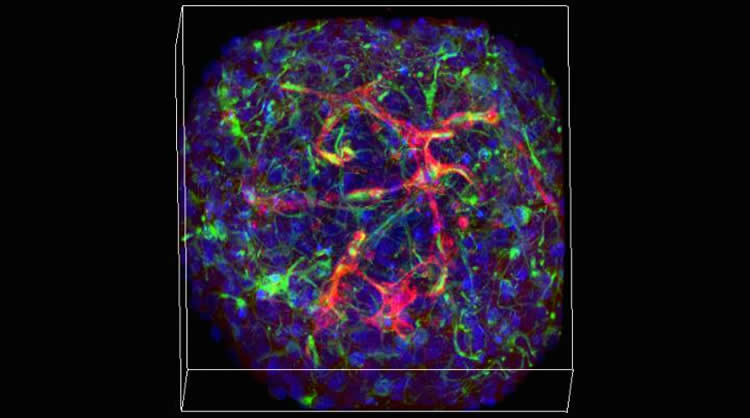Artificial mini brains can produce blood vessels themselves
What a brilliant discovery for humans when artificial mini brains can produce blood vessels today !
In 2015, Brown University scientists successfully developed a "mini brain" from the model created by 3D implantation of living nerve cells. The original aim of the scientists was to create a new model specimen that could help reduce human dependence on animal testing in finding and studying the effects of drugs, the Brain treatment and injury. Clinical trials on this mini brain can make the results more accurate.
But recently, scientists have discovered a surprising new thing about these mini brains: neurons are developing their blood vessels. This is an unexpected achievement for scientists. They could not foresee that neurons are electrically active, producing some types of brain neurons and arranging themselves in a natural three-dimensional structure .
However, producing only nerve cells is not enough. A brain needs more blood vessels to make the "transport system" transport blood to feed it. But as researchers continued to work with these models, they found that about two-thirds of the mini brain developed blood vessels.
"It's interesting because the brain actually has blood vessels," said Diane Hoffman-Kim, the study's lead author. " We are in-depth understanding of it. Our neurons have carried out their own tasks. What they create is very close to some blood vessels. If we continue to study the model The brain's lab, we will get more surprises by raising these mini brains so that they can also own their own blood vessels. "

Transverse slices of artificial mini brains.
By taking photos of small brain blood vessels, the researchers were able to identify cells and proteins as they could be found in normal blood vessels. With a transect study under an electron microscope, they revealed that the vascular tubes have a suitable structure to carry the blood to the brain. This system is not as dense as in a real brain and they tend to remain only for a week or two. But this finding adds to the usefulness of the mini-brain.
"We can study a variety of injury conditions with many drugs being tested and some evil diseases - such as stroke and diabetes - about how well they fit together , " Hoffman-Kim mentioned more.
The mini brain itself creates blood vessels that opens a new door for better research on stroke, Alzheimer's disease and other types of neurological attacks just thanks to the mini brain instead of animals like before. The study was published in The Journal of Neuroscience Methods. Brown University team of scientists illustrated their findings in the video below.
The video illustrates a new discovery about the mini brain of Brown University scientists
- 3D blood vessels
- Green light helps thicken artificial blood vessels
- Austria successfully tested artificial blood vessels on mice
- Raising an artificial 6-month-old brain, for the first time, a baby-like brain wave is emitted
- Medical breakthrough: culture of blood vessel walls
- Artificial blood vessels from salmon skin
- The American scientists raised 'mini brains' to live up to 9 months in vitro
- A way to produce artificial blood has been found on an industrial scale
- Apple develops device that predicts heart attack by listening to blood vessels?
- Blood vessels cultured from skin cells
- 'In' artificial liver from sugar
- Breakthrough in the production of large-scale artificial blood
 Green tea cleans teeth better than mouthwash?
Green tea cleans teeth better than mouthwash? Death kiss: This is why you should not let anyone kiss your baby's lips
Death kiss: This is why you should not let anyone kiss your baby's lips What is salmonellosis?
What is salmonellosis? Caution should be exercised when using aloe vera through eating and drinking
Caution should be exercised when using aloe vera through eating and drinking Does exercising our minds a lot help us burn excess calories?
Does exercising our minds a lot help us burn excess calories?  How did Egyptian mummies remove the brain from the body?
How did Egyptian mummies remove the brain from the body?  Shocking evidence that near-death experiences are real in people who have had cardiac arrest
Shocking evidence that near-death experiences are real in people who have had cardiac arrest  AI has been able to accurately reproduce more than 80% of images in the human brain.
AI has been able to accurately reproduce more than 80% of images in the human brain.  Neuralink tests controlling a robotic arm with thoughts
Neuralink tests controlling a robotic arm with thoughts  Elon Musk's ambition to merge humans with AI
Elon Musk's ambition to merge humans with AI 